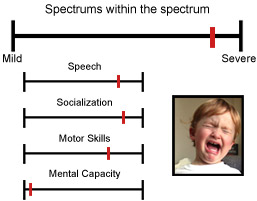Autism Symptoms Checklist
 The characteristics (or autism symptoms or signs) are easy to recognize when you’ve been around the disability long enough. You may think of this as an autism checklist or a list of abnormal behaviors. But by no means is this an all-encompassing exhaustive list of autism symptoms.
The characteristics (or autism symptoms or signs) are easy to recognize when you’ve been around the disability long enough. You may think of this as an autism checklist or a list of abnormal behaviors. But by no means is this an all-encompassing exhaustive list of autism symptoms.
Keep in mind that all of these symptoms can vary from mild to severe, or as I like to say, from mild to wild. Some autistic children are really easy to diagnose due to the severity of their symptoms. Others may be on the gray line between Asperger’s Disorder and Autistic Disorder since they both share common symptoms.
In reality all children with autism spectrum disorders have spectrums within the main autism spectrum. See the diagram on the right for a good visual example. And if you suspect your child has autism there are certain steps you should take to get help.
In reality even typical people have spectrums within spectrums because everybody has areas of strengths and areas of weaknesses. Likewise with autistics. Some of them are brilliant and display savant skills that amaze.
Remember, not every autistic child displays ALL of these symptoms. For instance, my son was never resistant to cuddling and is not hyper-sensitive to sound or touch. He also has no problem transitioning from one thing to another.
Early Symptoms of Autism
• No babbling by 12 months
• Loss of speech and skills previously acquired at any age
• No walking by 15 months
• Lack of facial expression, no big smiles
• No words by 16 months
• No pointing, showing, etc by 12 months
Signs of Autism
• | Little or no eye contact |
• | Child appears to be deaf, even though his hearing tests within the normal range. For example, when you call his name he doesn’t respond |
• | Delays in speech or complete absence of speech |
• | Child repeats what other people say verbatim |
• | Flapping of the hands or waving arms |
• | Repetitive rocking or spinning |
• | Delays in walking |
• | Walks or runs with an awkward gait |
• | Engages in repetitive behavior and routines |
• | Inappropriately plays with toys, such as holding a car upside-down and spinning the wheels |
• | Child seems to be in his “own world”, prefers isolation |
• | Child rarely smiles or generally has a blank expression on his face |
• | Resistance to cuddling or close contact and affection |
• | Preference for order, such as lining up toy cars |
• | Child appears to be fearless, not worried about strangers |
• | No separation anxiety when parted from parents |
• | Unusual or limited activities and interests |
• | Hyper sensitive to sensory stimuli such as touch, sound, etc. |
• | High pain tolerance |
• | Beats his head against walls, stairs, etc. |
• | No imaginative play, i.e. no pretending |
• | Cannot sit still, lacks patience |
• | Delays in motor skills |
• | Low muscle tone |
• | Does not like change, resists transition |